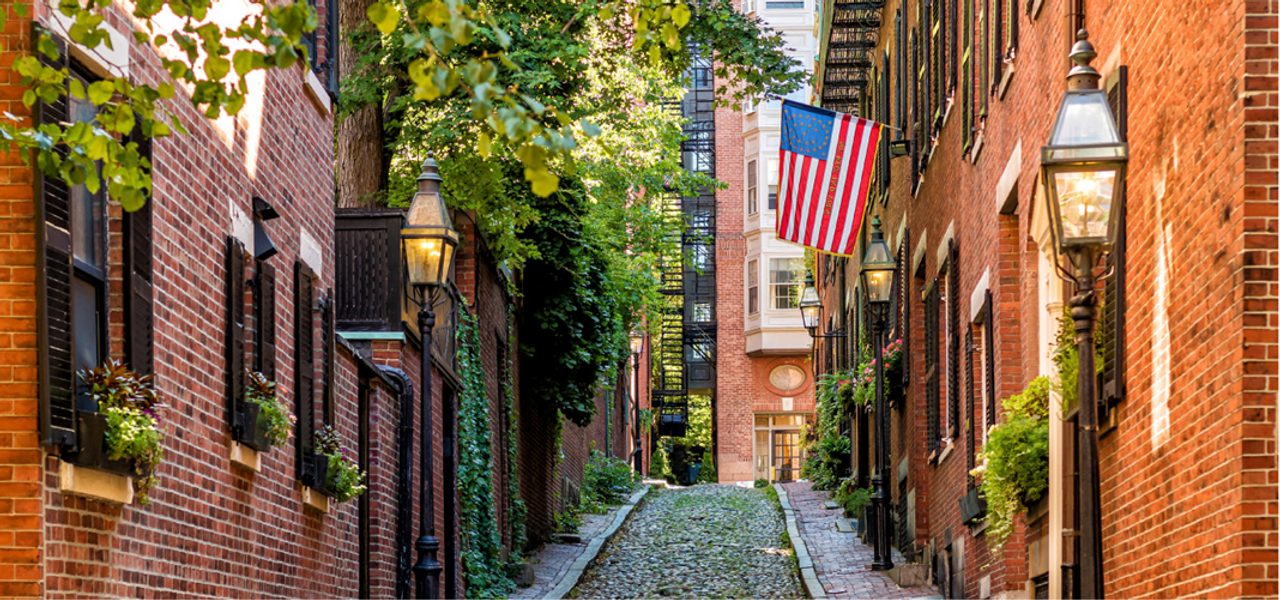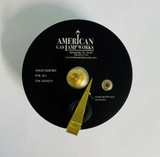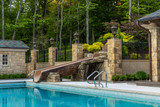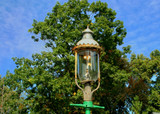Lighting That Shapes the Neighborhood's Character
Boston’s Beacon Hill Historic District is characterized by its narrow, gas-lit streets and brick row houses. Beacon Hill has an old-world charm that draws visitors and residents alike. The historic lighting in Beacon Hill is a key reason for its unique ambiance.
Historic lighting in Beacon Hill goes beyond functionality. Like all great historic street lamp choices, it enhances the district’s aesthetic appeal and serves as a reminder of the past. The soft glow of gas lamps creates a warm and inviting atmosphere, transporting people back in time. This type of lighting complements the cobblestone streets and Federal-style homes.
Beacon Hill’s historic lighting fixtures are not just visually appealing. They also reflect the craftsmanship and techniques used during the 19th century. Handcrafted from components formed by pouring liquid metal into sand-mold patterns, modern gas lanterns are both sturdy and elegant. This foundry-casting technique results in fixtures that are far more durable and attractive than those made from bent and soldered sheet metal.
The importance of historic lighting in Beacon Hill cannot be overstated. Walking through Beacon Hill at night, under the gentle glow of these historic lamps, offers a glimpse into the past, making the district a living museum of Boston’s architectural heritage.
The Technology Behind Historic Lighting in Beacon Hill
Historic gas lighting technology in Beacon Hill dates back to the early 19th century. Unlike modern lighting systems, these fixtures were created using a foundry-casting technique. Liquid metal is poured into sand-mold patterns to form the components of each lamp. This process results in fixtures that are both strong and elegant. The attention to detail in crafting these lamps ensures they blend in with Beacon Hill’s architectural style.
Most modern gas lanterns are made from bent and soldered sheet metal. This method produces fixtures that are functional but lack the aesthetic and structural integrity of foundry-cast lamps. The handcrafted nature of Beacon Hill’s historic lamps means each one is unique, with a level of detail that mass-produced fixtures cannot match. This craftsmanship is evident in the intricate designs and sturdy construction of each lamp.
The durability of these fixtures is another key advantage. Foundry-cast lamps are resistant to weathering and wear, making them ideal for outdoor use. The materials and construction methods used ensure these lamps can withstand the test of time, maintaining their beauty and functionality for many years. This durability reduces the need for frequent replacements and maintenance, preserving the historic character of Beacon Hill.
Historic lighting technology in Beacon Hill combines traditional methods with timeless design. The use of foundry-casting techniques results in fixtures that are not only visually appealing but also highly durable. These lamps play a vital role in maintaining the neighborhood’s charm, providing both light and a tangible link to the past.
Conservation Efforts: Preserving Beacon Hill's Nighttime Glow
Conservation efforts in Beacon Hill focus on maintaining the historic charm of the neighborhood while embracing modern advancements. Preserving the integrity of the gas lamps is a key aspect of these efforts. These lamps, which have been a part of Beacon Hill’s streetscape for centuries, require meticulous care and attention to ensure they continue to function and contribute to the area’s unique ambiance.
One of the main challenges in conserving these historic gas lamps is the balance between maintaining their traditional appearance and incorporating energy-efficient technologies. Conversion projects like Beacon Hill are essential in this regard. These projects aim to upgrade the lighting systems without compromising the historic aesthetic of the neighborhood. By transitioning to LED technology, these areas can reduce energy consumption while preserving the soft, warm glow characteristic of gas lighting.
The Oakmont, Pennsylvania lighting conversion project is a notable example of successful integration. This project involved replacing traditional gas lamps with LED fixtures designed to mimic the appearance and light quality of the original lamps.
Conservation efforts extend beyond technological upgrades. Regular maintenance and restoration work are critical to preserving the historic gas lamps. This includes cleaning, repairing, and replacing parts as needed to keep the lamps in optimal condition. Skilled craftsmen who understand the traditional techniques used in the original construction of these lamps are often involved in this work, ensuring that any repairs or replacements are faithful to the original design.
Preserving Beacon Hill’s nighttime glow involves a combination of maintaining traditional gas lamps and embracing modern, energy-efficient technologies. Conversion projects like those in Oakmont and ongoing maintenance efforts are essential in keeping the historic charm of the neighborhood intact. Through these efforts, the distinctive character of Beacon Hill’s nighttime environment continues to be a source of pride and attraction for both residents and visitors.
Beacon Hill's Lighting in Art and Culture
Beacon Hill has long inspired artists and writers, becoming a cultural touchstone in Boston. The neighborhood’s unique charm, accentuated by its historic lighting, has been a muse for many.
The Beacon Hill Art Walk is a notable event that showcases the work of local artists. Held annually, this event transforms the neighborhood into an open-air gallery, with artists displaying their work along the picturesque streets and gardens. This tradition highlights how Beacon Hill’s historic ambiance, enhanced by its iconic gas lamps, provides a perfect backdrop for artistic expression. The Art Walk not only celebrates the community’s artistic talent but also underscores the importance of preserving the neighborhood’s unique visual appeal (Artists Crossing Boston).
Literature also finds a significant place in Beacon Hill’s cultural landscape. Renowned author Louisa May Alcott, best known for her novel “Little Women,” lived and wrote in Beacon Hill. Alcott’s time in the neighborhood influenced her work, with the serene and historic setting of Beacon Hill often reflected in her writing. Alcott’s former residence on Pinckney Street is a testament to the literary heritage of the area. Walking through the gas-lit streets, one can imagine the inspiration that Alcott and her contemporaries drew from their surroundings.
The influence of Beacon Hill extends to other writers and artists as well. The cobblestone streets and historic lighting have been featured in numerous films and photographs, capturing the timeless beauty of the neighborhood. These visual and literary works contribute to Beacon Hill’s reputation as a place where history and art converge.
The neighborhood’s historic lighting not only preserves its past but also continues to inspire. By maintaining these fixtures, Beacon Hill keeps alive the artistic and literary legacy that defines its character.
Modern Adaptations: Embracing LED Technology
In recent years, there has been a shift towards incorporating LED technology into historic lighting systems while maintaining the traditional aesthetics of neighborhoods like Beacon Hill. This transition addresses the need for energy efficiency and sustainability without compromising the visual appeal that defines the historic district.
LED lighting offers several advantages over traditional gas lamps. LEDs consume significantly less energy, which translates into lower operational costs and reduced environmental impact. They also have a longer lifespan compared to gas lamps, which reduces the frequency of maintenance and replacement. These benefits make LEDs a practical choice for preserving historic areas.
The project to convert gas lamp posts to electric in Beacon Hill and Oakmont highlights successful examples of integrating LED technology. In Beacon Hill, the project involved replacing old gas lamps with LED fixtures designed to replicate the warm glow of gas lighting. This careful consideration ensures that the new fixtures blend seamlessly with the neighborhood’s historic ambiance. The LED lights used in these projects mimic the color temperature and light distribution of traditional gas lamps, preserving the soft, inviting atmosphere of the area.
The Oakmont conversion project serves as another great example. This initiative replaced traditional gas lamps with LED fixtures while maintaining the original design and aesthetic. The project demonstrated that it is possible to achieve energy efficiency and sustainability without altering the historic character of a neighborhood. The LED fixtures used in Oakmont are crafted to look identical to their gas counterparts.
The future of historic lighting lies in finding a balance between preservation and innovation. By adopting LED technology, historic districts like Beacon Hill can continue to showcase their timeless beauty while benefiting from the advancements of modern lighting systems. This approach ensures that the unique character of these neighborhoods is preserved for future generations to enjoy.
Conclusion
The introduction of LED technology into historic lighting systems demonstrates a successful balance between preserving the past and embracing the future. Projects like those in Beacon Hill and Oakmont showcase how modern adaptations can enhance energy efficiency and reduce maintenance costs without compromising the visual appeal of historic districts. The careful replication of traditional gas lamps with LED fixtures ensures that the neighborhood retains its warm, inviting glow, a hallmark of its character. With the extra incentive supplied by historic tax credits, there are even more people and communities interested in converting their own gas lamps to electric LEDs.
If you’re one of those people or community representatives looking to enhance their own outdoor spaces with beautiful and durable lighting fixtures, American Gas Lamp Works offers a range of options. We’re experts in manufacturing and converting historic lighting fixtures ensures that you can enjoy the same elegance and durability found in Beacon Hill’s historic lamps.
Contact American Gas Lamp Works today for a free design consultation.
Key Takeaways
- Historical Significance: Beacon Hill’s historic lighting plays a crucial role in preserving the neighborhood’s old-world charm, enhancing its aesthetic appeal, and providing a tangible link to Boston’s architectural heritage.
- Craftsmanship and Technology: The gas lamps in Beacon Hill are handcrafted using a foundry-casting technique, which results in durable and visually appealing fixtures. This traditional method contrasts with modern bent and soldered sheet metal lanterns, highlighting the unique craftsmanship of Beacon Hill’s lighting.
- Conservation Efforts: Efforts to preserve Beacon Hill’s historic gas lamps involve balancing the maintenance of traditional appearances with the integration of modern, energy-efficient technologies like LED lighting. Successful projects, such as those in Oakmont, demonstrate that this balance can be achieved without compromising the neighborhood’s historic character.
- Cultural Influence: Beacon Hill’s historic lighting has inspired numerous artists and writers. Events like the Beacon Hill Art Walk and the literary heritage of authors like Louisa May Alcott underscore the neighborhood’s cultural significance.
- Modern Adaptations: The shift towards LED technology in historic lighting systems addresses the need for energy efficiency and sustainability. LED fixtures, designed to replicate the appearance and light quality of traditional gas lamps, ensure that historic districts like Beacon Hill retain their timeless beauty while benefiting from modern advancements.
- Community Involvement: Residents and local organizations play a vital role in funding and supporting preservation projects, helping to maintain the historic and cultural heritage of their neighborhoods.
- Commercial Solutions: American Gas Lamp Works offers a range of options for those looking to enhance their outdoor spaces with beautiful, durable lighting fixtures. Their expertise in manufacturing and converting historic lighting fixtures ensures that customers can enjoy the elegance and durability found in Beacon Hill’s historic lamps.

Author: Patrick Jardini, President
Patrick Jardini is the President of American Gas Lamp Works, a manufacturer and distributor of gas and electric lighting, outdoor heaters, and custom fire bowls. Since purchasing the business, Mr. Jardini has focused on expanding both products and brand awareness through direct sales and strategic partnerships with gas utility providers. Patrick is a Pittsburgh native, Air Force veteran, and MBA graduate from the University of Pittsburgh, and has a professional background in metals production, sales, and marketing.







